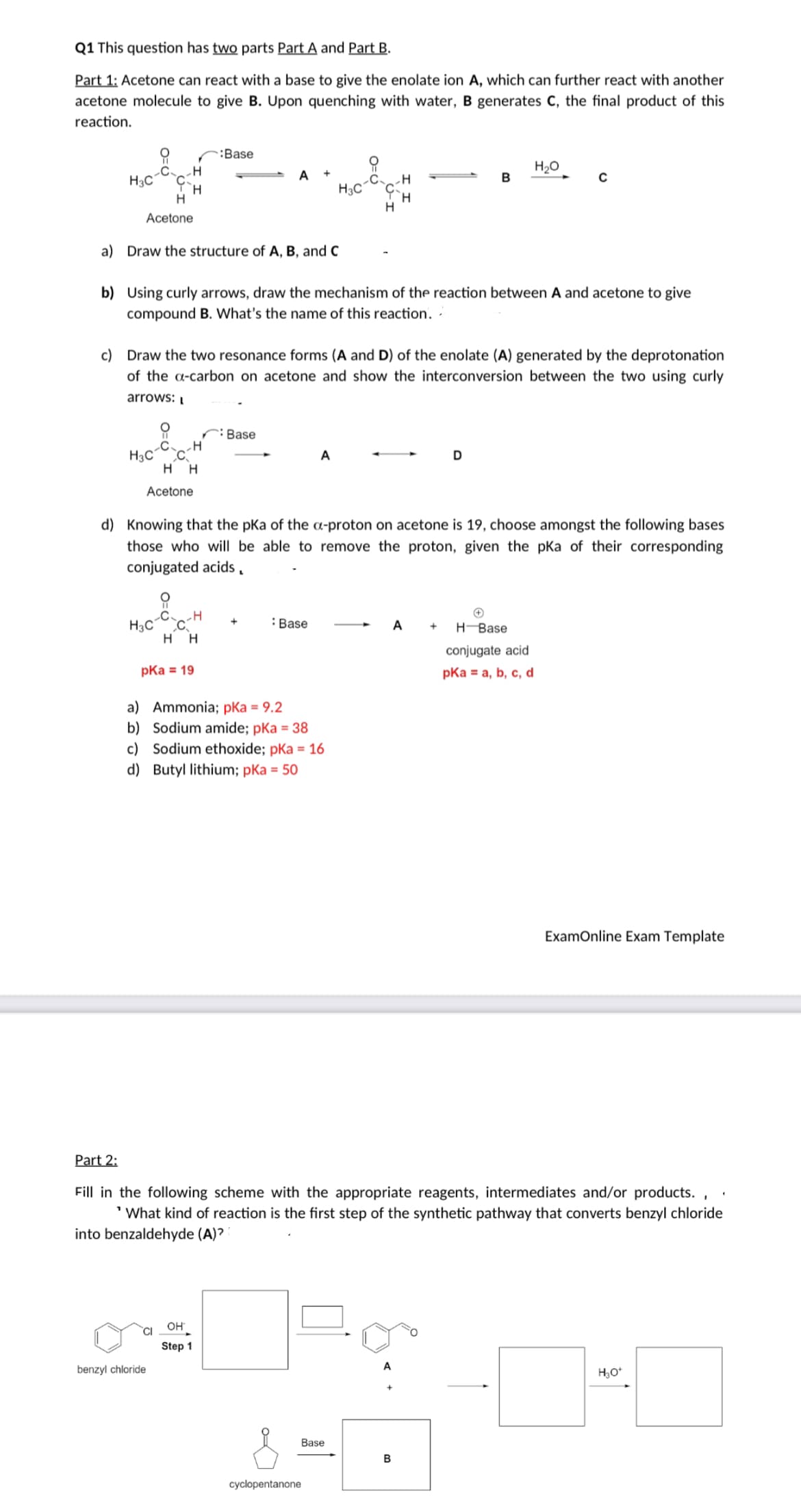Q1 This question has two parts Part A and Part B. Part 1: Acetone can react with a base to give the enolate ion A, which can further react with another acetone molecule to give B. Upon quenching with water, B generates C, the final product of this reaction. :Base H20 C H3C A H. H. H3C H. Acetone a) Draw the structure of A, B, and C b) Using curly arrows, draw the mechanism of the reaction between A and acetone to give compound B. What's the name of this reaction. - c) Draw the two resonance forms (A and D) of the enolate (A) generated by the deprotonation of the a-carbon on acetone and show the interconversion between the two using curly arrows: :Base H3C° H H Acetone
Q1 This question has two parts Part A and Part B. Part 1: Acetone can react with a base to give the enolate ion A, which can further react with another acetone molecule to give B. Upon quenching with water, B generates C, the final product of this reaction. :Base H20 C H3C A H. H. H3C H. Acetone a) Draw the structure of A, B, and C b) Using curly arrows, draw the mechanism of the reaction between A and acetone to give compound B. What's the name of this reaction. - c) Draw the two resonance forms (A and D) of the enolate (A) generated by the deprotonation of the a-carbon on acetone and show the interconversion between the two using curly arrows: :Base H3C° H H Acetone
Organic Chemistry: A Guided Inquiry
2nd Edition
ISBN:9780618974122
Author:Andrei Straumanis
Publisher:Andrei Straumanis
Chapter13: Substitution
Section: Chapter Questions
Problem 13E
Related questions
Question

Transcribed Image Text:Q1 This question has two parts Part A and Part B.
Part 1: Acetone can react with a base to give the enolate ion A, which can further react with another
acetone molecule to give B. Upon quenching with water, B generates C, the final product of this
reaction.
:Base
H20
A
H3C
H.
H3C
H.
Acetone
a) Draw the structure of A, B, and C
b) Using curly arrows, draw the mechanism of the reaction between A and acetone to give
compound B. What's the name of this reaction. -
c) Draw the two resonance forms (A and D) of the enolate (A) generated by the deprotonation
of the a-carbon on acetone and show the interconversion between the two using curly
arrows: I
Base
H3C
H
A
D
H
Acetone
d) Knowing that the pka of the a-proton on acetone is 19, choose amongst the following bases
those who will be able to remove the proton, given the pKa of their corresponding
conjugated acids.
H3C-C-H
H H
:Base
H-Base
+
conjugate acid
pka = 19
pКa 3 а, b, с, d
a) Ammonia; pKa = 9.2
b) Sodium amide; pka = 38
c) Sodium ethoxide; pka = 16
d) Butyl lithium; pKa = 50
ExamOnline Exam Template
Part 2:
Fill in the following scheme with the appropriate reagents, intermediates and/or products. ,
' What kind of reaction is the first step of the synthetic pathway that converts benzyl chloride
into benzaldehyde (A)?
он
Step 1
A
benzyl chloride
Base
cyclopentanone
Expert Solution
This question has been solved!
Explore an expertly crafted, step-by-step solution for a thorough understanding of key concepts.
Step by step
Solved in 2 steps with 1 images

Knowledge Booster
Learn more about
Need a deep-dive on the concept behind this application? Look no further. Learn more about this topic, chemistry and related others by exploring similar questions and additional content below.Recommended textbooks for you

Organic Chemistry: A Guided Inquiry
Chemistry
ISBN:
9780618974122
Author:
Andrei Straumanis
Publisher:
Cengage Learning

World of Chemistry, 3rd edition
Chemistry
ISBN:
9781133109655
Author:
Steven S. Zumdahl, Susan L. Zumdahl, Donald J. DeCoste
Publisher:
Brooks / Cole / Cengage Learning

Organic Chemistry: A Guided Inquiry
Chemistry
ISBN:
9780618974122
Author:
Andrei Straumanis
Publisher:
Cengage Learning

World of Chemistry, 3rd edition
Chemistry
ISBN:
9781133109655
Author:
Steven S. Zumdahl, Susan L. Zumdahl, Donald J. DeCoste
Publisher:
Brooks / Cole / Cengage Learning